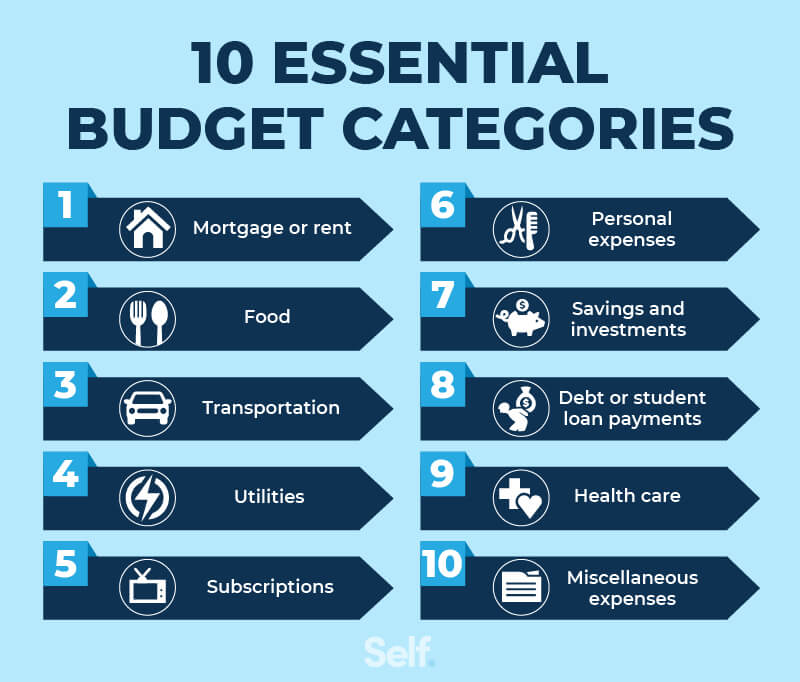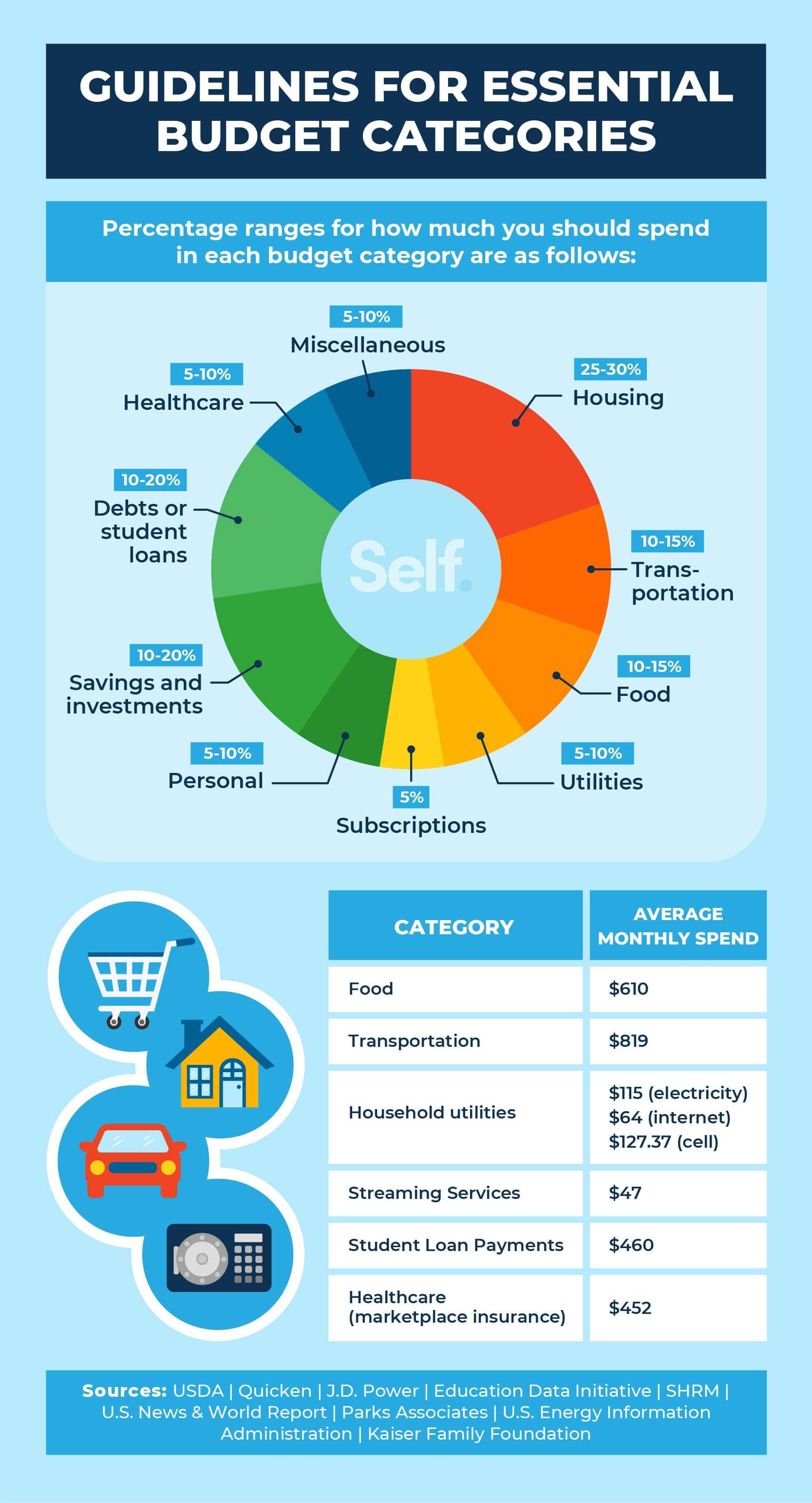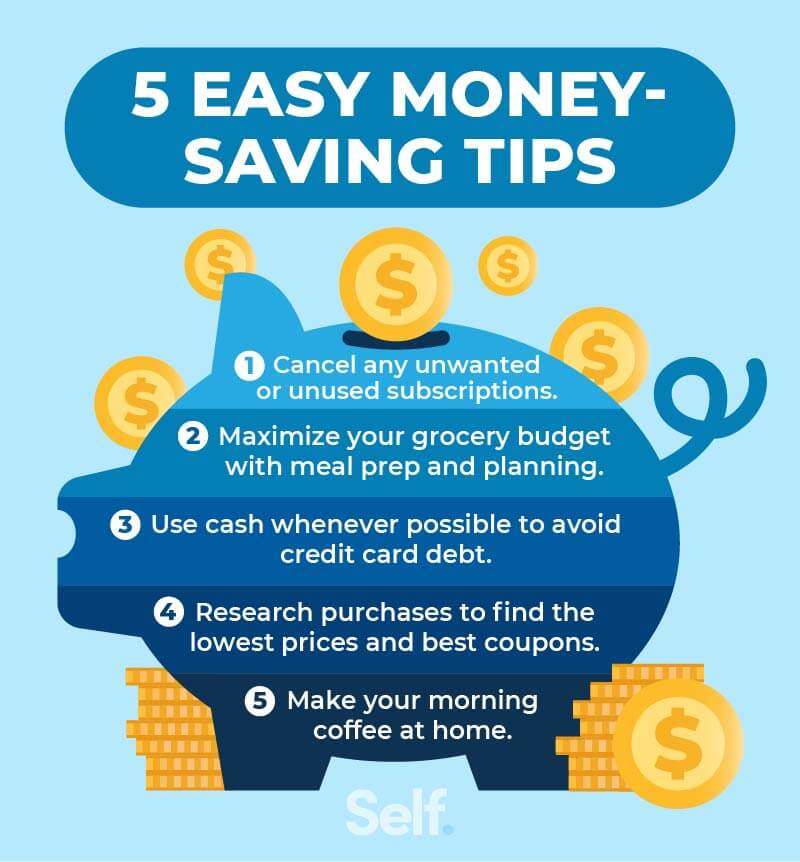10 Essential Budget Categories for Your Financial Needs
Published on: 01/31/2022
When creating a budget, it’s important to consider the different budget categories to include in your plan. Not only do these categories give you a better snapshot of your overall personal or household expenses, but they also help you identify where you can afford to spend more and where you should spend less to meet your financial goals.
Here are 10 essential budget categories to consider including in your plan:
1. Mortgage or rent
2. Food
3. Transportation
4. Utilities
5. Subscriptions
6. Personal expenses
7. Savings and investments
8. Debt or student loan payments
9. Health care
10. Miscellaneous expenses

1. Housing
Deciding how much to spend on housing, whether you rent or own, depends on two important factors: your income and your debt.
How much should you budget?
One common rule of thumb is to spend about 30% to 33% of your income on housing. This figure includes renters or homeowners insurance, utilities, and property taxes.
Another benchmark worth considering is the 28/36 rule, which takes into account both expenses and debt. Under this rule, your housing expenses shouldn’t be higher than 28%, and your total debt obligations shouldn’t be higher than 36% of your income.[1]
What does this include?
As mentioned, rent or mortgage payments are just the beginning.
If you’re a member of a homeowners’ association (HOA), you will need to consider dues. If you’re paying rent, you will also want to factor in renters insurance and how much you will need. Similarly, if you own a home, you will need homeowners insurance.
If you own your home, there are also maintenance costs to consider. You’ll also need to pay property taxes, which vary significantly depending on where you live. As of 2019, they were as low as 0.31% in Hawaii and as high as 2.13% in New Jersey.[2] Several sites offer cost-of-living calculators that can help you compare.[3]
2. Food
Americans spend an average of $610 a month on food, including groceries and dining out.[4] You can use the USDA's general recommendations and guidelines to formulate a budget for yourself and your household.
How much should you budget?
Government research has found that people spend somewhere between 10% and 16% of their income on food.[5] The USDA has guidelines for different family sizes and income levels.[6]
The agency’s four tiers of grocery spending are Thrifty, Low-cost, Moderate-cost, and Liberal. Based on their recommendations, a single person aged 19-50 should spend $186.65-$370.75 per month, a couple in the same age range should spend $410.60-$815.60 per month, and a family of four with two young children should spend $599.00-$1,169.00 per month.
What does this include?
This category includes groceries. Some people choose to include dining out in this category as well. However, if you spend a significant amount of money every month dining out, you may want to create another budget category for that to better understand your spending.
One study found that it is nearly five times more expensive to have a meal delivered by a restaurant than to cook at home, and three times as expensive to use a meal kit than to cook from scratch.[7]
3. Transportation
For most people, transportation ranks as the second-most-expensive budget category, with an average monthly cost of about $819.[4]
How much should you budget?
Typically, budgeting 10%-15% of your monthly income should cover transportation costs.[8]
What does this include?
This includes the cost of your car payment (if you have one), as well as rideshare services, public transportation, gas, car maintenance (oil changes, tires, etc.), car insurance, taxis, parking fees, DMV fees, car rentals, and so forth.
Loyalty and membership programs like GasBuddy can save you money on fuel, and comparing and negotiating auto insurance premium costs can allow you to save on auto insurance.

4. Utilities
Utility costs, like housing costs, vary widely by state. In 2018, utilities cost more than $730 a month in Hawaii, but less than half that (under $344 a month) in Idaho.[9]
How much should you budget?
Utility costs will vary depending on where you live and how large your household is. 5%-10% of your monthly income is a good benchmark.[8]
What does this include?
Utility costs include electricity, phone service, water, garbage services, natural gas, internet service, and cell service.
Saving money on utilities can be as easy as resetting your thermostat. You can save up to 10% a year on your cooling and heating costs by turning your thermostat back 7 to 10 degrees from its normal setting eight hours a day.[10]
Other ways to save include conserving water by taking short showers and using low-flow toilets, and saving on utility costs by insulating your home well, switching to LED lightbulbs, and using EnergyStar appliances. You can also shop around for internet and cell phone service or negotiate your existing plans.
5. Subscriptions
According to a 2021 survey, the average American household spends $47 a month on streaming services, such as Netflix, Peacock, Hulu and others, just to include a few.[11]
How much should you budget?
Subscriptions can be bundled under a general entertainment category, which experts recommend not to spend more than ten percent in.[8]
What does this include?
Subscriptions can encompass a number of types of services, but they’re often forgotten about. The most common services people tend to use are streaming services, such as Netflix, Amazon Prime, Disney+ and Hulu. Other subscription services can be food-related, clothing-related or provide other kinds of entertainment.[12]
Prices on subscription services can increase without someone being aware. Many end up overspending on subscriptions they simply forgot to cancel after a free trial period. Therefore, it pays to revisit those commitments and cancel those you don’t use, or which may have increased in cost, exceeding what you’d budgeted.
6. Personal expenses
Monthly spending in this category will likely vary greatly from person to person, as everyone’s personal lives and needs are different.
How much should you budget?
Financial experts recommend spending between 5%-10% as an absolute maximum on personal expenses.[8]
What does this include?
Personal expenses can include things like your kids’ school supplies, daycare, clothing, pet care, gym memberships, trips to the barbershop or beauty salon, and so forth.
One way to save money in this category is by planning. It’s important to know the costs associated with having children or caring for pets before you decide to do so. Another way to save is by prioritizing. You may need to maintain a standard of dress on the job, but you might be able to take a pass on that expensive pair of new shoes.
Shop sales, but buy only what you need and came to buy. Impulse buys can be budget-killers, at the supermarket, department store, or online. Compare prices for things like child care, haircuts, and various personal care expenses.

7. Savings and investments
It’s easy to forget long-term investments and focus on day-to-day expenses when creating a budget, but it’s important to save, too — whether it’s for a rainy day, a goal such as a wedding or a car, or for retirement. But how much of your paycheck should you save?
How much should you budget?
The general recommendation from financial experts is to save three to six months’ worth of your monthly living expenses for an emergency fund, but that’s not always feasible for every household. Financial experts also recommend allocating between 10%-20% percent of your monthly income for savings and investments.[8]
What does this include?
Savings, investments, and emergency savings are all recommended, but not always feasible to budget into someone’s monthly expenses. However, the traditional subcategories in this section include a traditional bank-based savings account, retirement funds, 401(k), Roth IRA, and other such investments.
If you’re struggling to save money, some ways to save include collecting loose change or rounding up the change on purchases you make, then depositing it in savings (some banks allow you to do this). Consider saving a percentage of what you earn, rather than a dollar figure; this way, if your income goes up, so will your savings.
8. Debt or student loan payments
It’s important to include debt payments in your budget as well, whether you’re repaying a personal loan, tackling credit card debt, or paying off a student loan. Missed payments go on your credit report and hurt your credit score, so it’s important to stay on top of them.
How much should you budget?
Financial experts recommend allocating between 10%-20% of your monthly income to lower your outstanding debts.[8]
What does this include?
All types of debt, including credit card debt, should be factored into this budget category.
If you face the risk of losing something you need — such as your car — if you miss a payment, it’s a good idea to pay that debt off first. Then, consider paying off debts that can cost you extra in fees or interest penalties, and once you’ve addressed those two areas, make payments that could damage your credit if you fail to do so.
One method of paying off debt is the avalanche method, where you pay off obligations with the highest interest rates first. This saves you money on compound interest. Another option is the snowball system, in which you pay off the smallest debt first while making minimum payments on the others. Then, once that is paid off, you roll what you were paying on that into the next-smallest, and so forth.
9. Health care
As of 2020, the average worker paid $5,588 in out-of-pocket costs for health coverage.[13] In 2019, hospital spending accounted for close to one-third, or 31%, of health spending overall, while 20% went to physicians and clinics, and 10% went to prescription drugs. Smaller amounts went to things like nursing care, dental care, and home health care.[14]
How much should you budget?
Financial experts recommend spending between 5%-10% of your monthly income on healthcare. Depending on your medical needs, you may need to allocate more room in this category.[8]
What does this include?
Health care expenses include your premiums, deductible and copayments as they apply to doctor visits, hospital stays, prescriptions, and the like.
When budgeting for health care, you will want to take rising health care costs into account as well as changes in your own health needs from year to year. In 2021, employers reported seeing the highest annual increase in more than a decade, with the price of employer-sponsored health insurance jumping 6.3% per employee to $14,542.[15]
10. Miscellaneous expenses
Miscellaneous expenses are those that aren’t easy to categorize and might be very specific to your lifestyle.
How much should you budget?
Miscellaneous expenses can easily be considered a subcategory of personal expenses, depending on need, but financial experts recommend spending no more than 10% on this monthly. Spending between 5%-10% is best.[8]
What does this include?
In a miscellaneous budget category, you might include expenses related to a hobby or child support payments.
Some expenses might be easier to adjust than others. The important thing is not to forget to include items that don’t fall neatly into any specific category, as they’re still expenses you should consider.
Budgeting basics
Making a personal budget can give you a clear picture of your monthly cash flow. It can get you started with budgeting basics that will tell you where your money’s going, whether you’re operating at a deficit or a surplus, and what changes you might need to make.
Budgeting touches on all areas of your personal finance, from debt repayment to your retirement savings. But there’s no single method of creating a monthly budget. Here are a few strategies people use to make their financial lives easier and their goals more achievable.

The 50-30-20 budget method
Under the 50-30-20 method, you earmark 50% of your after-tax income for necessities, set aside 30% for your wants, and direct 20% toward savings and debt repayments. This enables you to create larger categories for a more general budget because you don’t need to be as detailed, but you can still determine where your money is going, broadly speaking.
On the negative side, the lack of detail could make it harder for you to prioritize specific expenses and identify which areas you need to cut.
Other popular budget methods
- Envelope budget: In this system, you use envelopes as mini-accounts for each section of your budget. You label each one according to its category (“transportation,” “utilities,” “rent,” etc.) and put the amount of money you’ve budgeted in each envelope. You then withdraw the money as needed, but you can’t spend more than what you’ve budgeted, because when it’s gone, it’s gone.
Free budgeting apps
Several budgeting apps are available for free to help you track your spending and stick to the plan you’ve adopted. Different apps have different focuses.
Twine is good for helping couples manage and save toward shared financial goals. Truebill is a good option for reducing wasteful spending by monitoring your subscriptions and looking for better utility rates. Cleo is a solid choice for personalized money management advice via a chatbot.
Wikibuy helps you save using coupons. Joy uses research into the psychology of spending to help you modify your savings and spending habits to improve your budget.
Your budget should always work for you
Your budget is a template for your financial life, both now and in the future. By understanding how much money you’re making and where you’re spending it, a comprehensive budget will help you pay your debts from the past, stay current on regular expenses, and plan for the future.
Whatever budgeting method you choose should further your general goal of financial well-being and the specific goals you set for yourself. Indeed, setting those goals — and creating a realistic plan to achieve them — is what the budgeting process is all about.
Sources
- CNBC. “Use the 30% and 28/36 rules to figure out how much you should be spending on housing,” https://www.cnbc.com/2021/07/14/how-much-of-your-income-you-should-spend-on-housing.html. Accessed December 22, 2021.
- Tax Foundation. “How High Are Property Taxes in Your State?” https://taxfoundation.org/high-state-property-taxes-2021/. Accessed December 22, 2021.
- CNN Money. “Cost of living: How far will my salary go in another city?” https://money.cnn.com/calculator/pf/cost-of-living/index.html. Accessed December 22, 2021.
- Quicken. “20 Average Monthly Expenses to Include in Your Budget,” https://www.quicken.com/blog/monthly-expenses/. Accessed December 22, 2021.
- American Express. “How Much Should I Spend on Groceries?” https://www.americanexpress.com/en-us/credit-cards/credit-intel/how-much-should-i-spend-on-groceries/. Accessed December 22, 2021.
- USDA. “USDA Food Plans: Cost of Food”. https://www.fns.usda.gov/cnpp/usda-food-plans-cost-food-reports. Accessed December 31, 2021.
- Forbes. “Here's How Much Money You Save By Cooking At Home,” https://www.forbes.com/sites/priceonomics/2018/07/10/heres-how-much-money-do-you-save-by-cooking-at-home/?sh=3233e28435e5. Accessed December 22, 2021.
- U.S. Bureau of Labor. “Consumer expenditures in 2020”. https://www.bls.gov/opub/reports/consumer-expenditures/2020/home.htm. Accessed December 31, 2021.
- MoveOn. “The Cost of Utilities: Which States Pay the Most?” https://www.move.org/which-states-pay-most-utilities/. Accessed December 22, 2021.
- Energy.gov. “Energy Saver,” https://www.energy.gov/energysaver/thermostats. Accessed December 22, 2021.
- J.D. Power. “New Streaming Services Cut into Netflix’s Market Share, While “The Mandalorian” Drives Disney+ Viewership”. https://discover.jdpa.com/hubfs/Files/Industry%20Campaigns/TMT/New%20Streaming%20Services%20Cut%20into%20Netflixs%20Market%20Share%20While%20The%20Mandalor.._.pdf. Accessed December 30, 2021.
- PC Mag. “How to Track and Manage Your Paid Subscriptions,” https://www.pcmag.com/how-to/track-and-manage-your-paid-subscriptions. Accessed December 22, 2021.
- SHRM. “Average Worker Paid $5,588 Out of Pocket for Family Health Coverage This Year,” https://www.shrm.org/resourcesandtools/hr-topics/benefits/pages/average-worker-paid-more-out-of-pocket-for-family-health-coverage.aspx. Accessed December 22, 2021.
- Health System Tracker. “How has U.S. spending on healthcare changed over time?” https://www.healthsystemtracker.org/chart-collection/u-s-spending-healthcare-changed-time/. Accessed December 22, 2021.
- Health Care Dive. “Employers report highest annual increase in per-employee health costs in over a decade,” https://www.healthcaredive.com/news/employers-annual-increase-per-employee-health-costs-mercer/611401/. Accessed December 22, 2021.
- U.S. Energy Information Administration. “Average monthly electric bill for U.S. residential customers declined in 2019”. https://www.eia.gov/todayinenergy/detail.php?id=46276. Accessed December 31, 2021.
- Kaiser Family Foundation. “Marketplace Average Benchmark Premiums”. https://www.kff.org/health-reform/state-indicator/marketplace-average-benchmark-premiums/?currentTimeframe=0&selectedDistributions=2021&sortModel=%7B%22colId%22:%22Location%22,%22sort%22:%22asc%22%7D. Accessed December 31, 2021.
- Parks Associates. “Parks Associates: As of Q1 2021, 41% of US Broadband Households Have Standalone Broadband Service, Paying an Average of $64 Per Month”. https://www.prnewswire.com/news-releases/parks-associates-as-of-q1-2021-41-of-us-broadband-households-have-standalone-broadband-service-paying-an-average-of-64-per-month-301313691.html. Accessed December 31, 2021.
About the author
Jeff Smith is the VP of Marketing at Self Financial. See his profile on LinkedIn.
About the reviewer
Ana Gonzalez Ribeiro, MBA, AFC® is an Accredited Financial Counselor® and a Bilingual Personal Finance Writer and Educator dedicated to helping populations that need financial literacy and counseling. Her informative articles have been published in various news outlets and websites including Huffington Post, Fidelity, Fox Business News, MSN and Yahoo Finance. She also founded the personal financial and motivational site www.AcetheJourney.com and translated into Spanish the book, Financial Advice for Blue Collar America by Kathryn B. Hauer, CFP. Ana teaches Spanish or English personal finance courses on behalf of the W!SE (Working In Support of Education) program has taught workshops for nonprofits in NYC.
